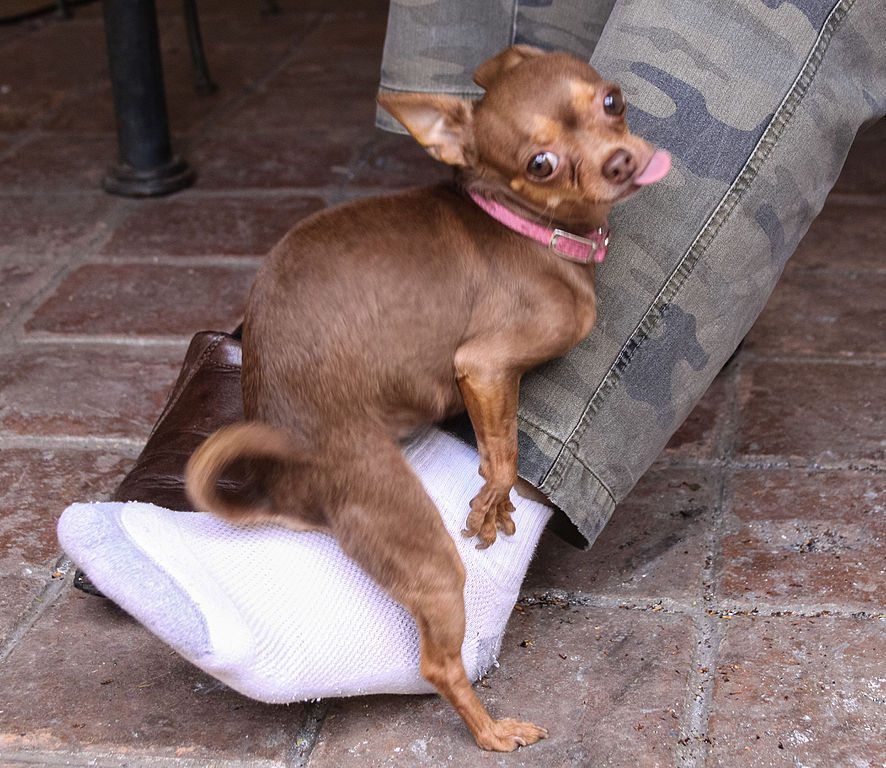Why does my dog hump?

The behavior of a dog humping, often observed in both male and female dogs, can puzzle, surprise, or even embarrass pet owners. But this act, which involves the dog mounting objects, people, or other animals, is a natural behavior that can stem from various underlying reasons.
Instincts at Play
To comprehend why dogs hump, we must first examine their evolutionary history. Dogs, as descendants of wolves, retain many instinctual behaviors ingrained in their genetic makeup. Among these behaviors is mounting or humping. In the wild, this behavior serves multiple purposes, including establishing dominance, asserting social status, or expressing arousal. While domestication has altered the context in which dogs exhibit such behaviors, the underlying instincts remain.
Dog Humping as Social and Sexual Behavior
One of the most pervasive misconceptions surrounding humping behavior in dogs is the assumption that it is exclusively driven by sexual arousal. While sexual motivation can indeed be a factor, particularly in intact male dogs, it is crucial to recognize that humping serves a variety of purposes beyond reproduction.
In the realm of sexual behavior, humping may occur as a display of courtship or mating behavior. In the context of interactions between intact male and female dogs, humping can serve as a precursor to mating, with the male attempting to initiate copulation. However, it is essential to distinguish between mating-related humping and other forms of humping behavior exhibited in different contexts.
Neutered dogs and female dogs also engage in humping behavior, challenging the notion that it is solely driven by sexual urges. Neutering, or spaying, reduces the production of sex hormones such as testosterone and estrogen, which can decrease the frequency of humping behavior in some dogs. However, humping may persist in neutered individuals due to other factors such as social dynamics, stress, or arousal.
Humping behavior in dogs is not limited to interactions with other dogs; it can also be directed towards humans, stuffed animals, or inanimate objects. In these instances, sexual motivation is unlikely to be the primary driver. Instead, humping may serve as a displacement behavior, a manifestation of excitement, frustration, or a response to environmental stimuli.
Playful Behavior and Excitement
Humping can also be a form of play or an expression of excitement. Dr. Carlo Siracusa, a veterinarian specializing in animal behavior, notes in an article for the American Kennel Club that dogs might hump as a part of playful interaction or when they are excited. It could be a way for them to release pent-up energy or show enthusiasm in response to particular stimuli.
Social Hierarchy and Dominance
In some cases, humping can be related to social hierarchy or dominance. Humping can serve as a way for dogs to assert dominance or show a higher social rank. This behavior might be seen in situations where dogs are trying to establish control or express their position within a group, not necessarily related to sexual intent.
Humping can also serve as a form of social communication among dogs. Dogs use various body language cues to convey messages to one another, and mounting is one such signal. It can indicate dominance or a desire to play, depending on the context. Dogs may engage in humping as a way to assert their position within a social hierarchy or to initiate interaction with other dogs.
Dog humping as a consequence of Stress or Anxiety
Much like humans, dogs experience a range of emotions, from joy and contentment to fear and frustration. These emotions can manifest in various behaviors, including humping. For instance, a dog experiencing heightened excitement or arousal may express these emotions through humping as a means of releasing pent-up energy. Conversely, a dog feeling stressed or anxious may resort to humping as a coping mechanism, seeking relief from internal turmoil through repetitive behavior.
In some cases, humping behavior in dogs can be indicative of compulsive tendencies. Compulsive behaviors, characterized by repetitive actions that serve no apparent purpose, can arise from a combination of genetic predisposition, environmental stressors, and underlying neurological factors. Dogs may engage in compulsive humping as a way to self-soothe or alleviate feelings of anxiety or discomfort. Understanding the root causes of compulsive behaviors is essential for effectively addressing and managing them.
Boredom and Understimulation
Dogs are intelligent, social creatures with a natural inclination towards exploration and activity. When deprived of mental stimulation and physical exercise, they may resort to behaviors like humping out of sheer boredom or frustration. Inadequate mental and physical enrichment can lead to an array of behavioral issues, including excessive humping. Providing dogs with opportunities for play, training, and interactive toys can help alleviate boredom and reduce the likelihood of compulsive behaviors.
For pet owners, addressing humping behavior involves a combination of training, providing mental and physical stimulation, and considering spaying or neutering. Additionally, consulting with a veterinarian or a certified animal behaviorist can provide guidance on managing and modifying this behavior.










